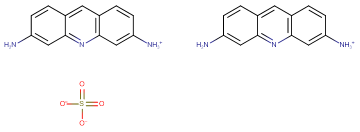
Proflavine Hemisulfate
CAS No. 1811-28-5
Proflavine Hemisulfate( Proflavine hemisulfate | Proflavine hemisulphate | EINECS 217-320-3 )
Catalog No. M12778 CAS No. 1811-28-5
Proflavine Hemisulfate is a topical antiseptic by interchelating DNA, thereby disrupting DNA synthesis and leading to high levels of mutation in the copied DNA strands.
Purity : >98% (HPLC)
 COA
COA
 Datasheet
Datasheet
 HNMR
HNMR
 HPLC
HPLC
 MSDS
MSDS
 Handing Instructions
Handing Instructions
| Size | Price / USD | Stock | Quantity |
| 50MG | 30 | In Stock |


|
| 100MG | 42 | In Stock |


|
| 200MG | 54 | In Stock |


|
| 500MG | Get Quote | In Stock |


|
| 1G | Get Quote | In Stock |


|
Biological Information
-
Product NameProflavine Hemisulfate
-
NoteResearch use only, not for human use.
-
Brief DescriptionProflavine Hemisulfate is a topical antiseptic by interchelating DNA, thereby disrupting DNA synthesis and leading to high levels of mutation in the copied DNA strands.
-
DescriptionProflavine Hemisulfate is a topical antiseptic by interchelating DNA, thereby disrupting DNA synthesis and leading to high levels of mutation in the copied DNA strands.(In Vitro):Proflavine (0.1-10 μM; 24 hours) inhibits the growth of Kir3.2-transformant cells and Kir3.2 activity in a concentration-dependent manner.Proflavine (300 μM) progressively reduces the current amplitude of Kir3.2 mutant to 27.7±4.3% of the control.(In Vivo):Proflavine (0.1-10 μM; 24 hours) inhibits the growth of Kir3.2-transformant cells and Kir3.2 activity in a concentration-dependent manner.Proflavine (300 μM) progressively reduces the current amplitude of Kir3.2 mutant to 27.7±4.3% of the control.
-
In VitroProflavine (0.1-10 μM; 24 hours) inhibits the growth of Kir3.2-transformant cells and Kir3.2 activity in a concentration-dependent manner. Proflavine (300 μM) progressively reduces the current amplitude of Kir3.2 mutant to 27.7±4.3% of the control. Cell Viability AssayCell Line:Kir3.2*-transformant BYT123 cells Concentration:0.1, 1, and 10 μM Incubation Time:24 hours Result:Dose-dependent inhibition of the growth of Kir3.2*-transformant cells. Attenuated the growth of Kir3.2*-transformant cells without affecting the growth of control cells.
-
In VivoThe concentrations of Proflavine (20 mg/kg) in whole blood after intravenous injection decreased rapidly at the beginning and remained stable from around 30 min after dosing. Animal Model:Adult male Sprague Dawley rats (weighing approximately 200 g) Dosage:20 mg/kg (Pharmacokinetic Analysis) Administration:Intravenous injection; 2, 4, 5, 10, 15, 20, 25, and 30 min after dosing Result:Concentration decreased rapidly from whole blood in the first 5 min after dosing, followed by a slower decrease.
-
SynonymsProflavine hemisulfate | Proflavine hemisulphate | EINECS 217-320-3
-
PathwayCell Cycle/DNA Damage
-
TargetDNA/RNA Synthesis
-
RecptorDNA mutation| LfrR| QacR| Thrombin
-
Research AreaInfection
-
Indication——
Chemical Information
-
CAS Number1811-28-5
-
Formula Weight516.57
-
Molecular FormulaC26H24N604S
-
Purity>98% (HPLC)
-
SolubilityWater: 22 mg/mL (85.18 mM)
-
SMILESC1=CC(=CC2=NC3=C(C=CC(=C3)[NH3+])C=C21)N.C1=CC(=CC2=NC3=C(C=CC(=C3)[NH3+])C=C21)N.[O-]S(=O)(=O)[O-]
-
Chemical Name(6-aminoacridin-3-yl)azanium;sulfate
Shipping & Storage Information
-
Storage(-20℃)
-
ShippingWith Ice Pack
-
Stability≥ 2 years
Reference
1.Stokowa K, et al. J Inorg Biochem, 2012, 106(1), 111-116.
molnova catalog



related products
-
SMN-C3
SMN-C3 (MV8T2MCK57) is an orally active modulator of SMN2 splicing, and has the potential to treat spinal muscular atrophy (SMA).
-
Hydroxyurea
Hydroxyurea is an antineoplastic agent that inhibits DNA synthesis through the inhibition of ribonucleoside diphosphate reductase.
-
Procarbazine hydroch...
Procarbazine hydrochloride (Matulane) is a hydrochloride salt form of procarbazine which is a polyfunctional alkylating compound used as an antineoplastic agent.



 Cart
Cart
 sales@molnova.com
sales@molnova.com


